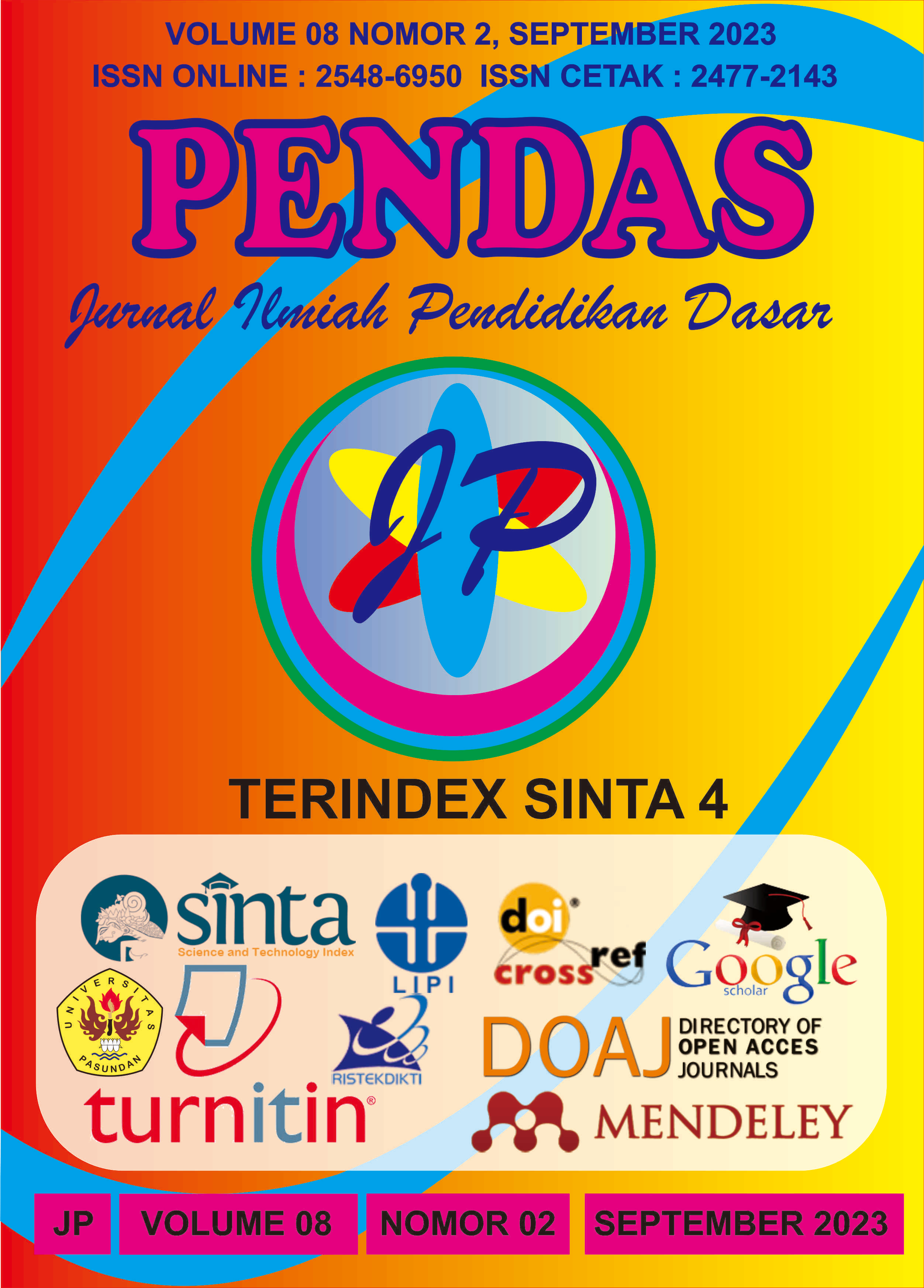KEEFEKTIFAN MODEL PEMBELAJARAN PBL (PROBLEM BASED LEARNING) BERBANTU MEDIA GAMBAR CERITA UNTUK MENINGKATKAN KEMAMPUAN BERFIKIR KRITIS KELAS II SD NEGERI SUMBERAGUNG 01 PATI
DOI:
https://doi.org/10.23969/jp.v8i2.9901Keywords:
Problem Based Learning Model, Critical Thinking AbilityAbstract
The Effectiveness of Using the Problem Based Learning Model with the help of Picture Story Media to Improve Critical Thinking Skills for Class II Students of SD Negeri Sumberagung 01, Pati. The background on students' ability to think critically is still low with an average of 44% complete, while 88% are incomplete. The problem in this study is the effectiveness of using the Problem Based Learning model for the critical thinking skills of second grade students of SD Negeri Sumberagung 01. The purpose of this research is to determine the effectiveness of using the Problem Based Learning Model assisted by Picture Story Media to Improve Critical Thinking Ability of Grade II Students of Public Elementary Schools Sumberagung 01, Pati. This type of quantitative research is in the form of Pre-Experimental Design with the research design used in the research, namely Pre-Experimental Designs with the type of one-group pretest-posttest designs. The research population was all students in class II SD Negeri Sumberagung 01. The samples taken were all students in class II totaling 11 students. Based on the calculations, the pretest results obtained were 0% of students who passed and 100% of students who did not complete. While the results of the posttest were 91% of students who completed and 9% of students who did not complete with an average posttest of 87.7. The results of the analysis of the ttest results stated that the tcount value was 11.983. Because tcount> ttable is 11.983> 2.179, then H0 is rejected and Ha is accepted. It can be concluded that there is effectiveness in using the Problem Based Learning model for the critical thinking skills of class II students at SD Negeri Sumberagung 01. This Problem Based Learning learning model can be used as an alternative teacher to teach so that students are more active during the learning process and students' critical thinking skills can be increased.Downloads
References
Aisyah, S., & Astuti, R. (2021). Analisis Mengenai Telaah Kurikulum K-13 pada Jenjang Sekolah Dasar. Jurnal Basicedu, 5(6), 6120–6125. https://doi.org/10.31004/basicedu.v5i6.1770
Ariana, R. (2016). Efektivitas pembelajaran. 1–23.
Arikunto, S. (2015). Dasar-Dasar Evaluasi Pendidikan.
Arsyad, E. (2019). Upaya Meningkatkan Aktivitas dan Hasil Belajar Matematika Berbasis PBL. Ideas: Jurnal Pendidikan, Sosial Dan Budaya, 5(4), 425. https://doi.org/10.32884/ideas.v5i4.232
Carin, A.A. & Sund, R. . (1394). Model Problem Based Learning.
Dimyani. (2009). Belajar dan Pembelajaran.
Djonomiarjo, T. (2020). Pengaruh Model Problem Based Learning Terhadap Hasil Belajar. Aksara: Jurnal Ilmu Pendidikan Nonformal, 5(1), 39. https://doi.org/10.37905/aksara.5.1.39-46.2019
Ety Nur Inah. (2015). PERAN KOMUNIKASI DALAM INTERAKSI GURU DAN SISWA Ety Nur Inah. Al-Ta’dib, 8(2), 150–167.
Faizah, S. N. (2017). HAKIKAT BELAJAR DAN PEMBELAJARAN Silviana. At-Thullab: Jurnal Pendidikan Guru Madrasah Ibtidaiyah Volume, 1(2), 176–185. file:///C:/Users/Hp/Downloads/322523223 (1).pdf
Fathurrohman, M. (2017). MODEL-MODEL PEMBELAJARAN INOVATIF (N. Hidayah (ed.); p. 114). AR-RUZZ MEDIA.
Festiawan, R. (2020). Belajar dan pendekatan pembelajaran. Jurnal K, 1–17.
Hidayani, M. (2016). PEMBELAJARAN TEMATIK DALAM KURIKULUM 2013 Masrifa Hidayani. At-Ta’lim: Jurnal Pendidikan Islam, 15(1), 150–165.
Hotimah, H. (2020). Penerapan Metode Pembelajaran Problem Based Learning Dalam Meningkatkan Kemampuan Bercerita Pada Siswa Sekolah Dasar. Jurnal Edukasi, 7(3), 5. https://doi.org/10.19184/jukasi.v7i3.21599
Ikhsani, S. R., Tangawunisma, A., Sholeha, A., Divanka, P., & Setiabudi, D. I. (2023). Karakteristik Pembelajaran Tematik Yang Ideal Pada Sekolah Dasar. 1(1), 1–6.
Jeklin, A. (2017). Pembelajaran Matematis Siswa. July, 1–23.
Lufiana, E. (2018). Model dan Metode Pembelajaran Yang Digunakan Guru Dalam Pelaksanaan Kurikulum 2013 Di SDI Miftahul Huda Plosokandang Kedungwaru Tulungagung Tahun Ajaran 2017/2018. Skripsi, 13–42. http://repo.iain-tulungagung.ac.id/9494/5/BAB II.pdf
Ma’rifah, S. S. (2018). 'HELPER” Jurnal Bimbingan dan Konseling FKIP UNIPA. Jurnal Bimbingan Dan Konseling FKIP UNIPA, 35(1), 31–46.
MA, H. W. (2018). Pengaruh Layanan Konseling Individual Terhadap Perkembangan Konsep Diri Siswa Kelas X Sma Melati Binjai Tahun Pelajaran 2018/2019. Serunai : Jurnal Ilmiah Ilmu Pendidikan, 3(2), 96–107. https://doi.org/10.37755/sjip.v3i2.45
Magdalena, I., & Dkk. (2020). Effective Management of Online Learning During the Pandemic at SDN 1 Tanah Tinggi. Edukasi Dan Sains, 2(01), 366–377. https://ejournal.stitpn.ac.id/index.php/bintang
Nafiqoh, H. (2020). PEMBELAJARAN BASED LEARNING. https://cls.ikipsiliwangi.ac.id/blog/pembelajaran-problem-based-learning#:~:text=Pembelajaran berbasis masalah atau sering,dunia nyata di awal pembelajaran
Oktaviani, W. (2018). Penerapan Model Pembelajaran Discovery Learning Untuk Meningkatkan Kemampuan Berpikir Kritis Dan Hasil Belajar Matematika Siswa Kelas 5 Sd. Jurnal Basicedu, 2(2), 5–10. https://doi.org/10.31004/basicedu.v2i2.137
Qomariyah, E. N. (2017). Pengaruh problem based learning (PBL) terhadap kemampuan berpikir kritis IPS. Jurnal Pendidikan Dan Pembelajaran, 23(2), 132–141.
Rachmadtullah, R. (2015). Kemampuan Berpikir Kritis Dan Konsep Diri Dengan Hasil Belajar Pendidikan Kewarganegaraan Siswa Kelas V Sekolah Dasar. Jurnal Pendidikan Dasar, 6(2), 287. https://doi.org/10.21009/jpd.062.10
RAHMAWATI, K. D. (2017). Analisis Model Pembelajaran Kooperatif Tipe Stad Dalam Pembelajaran Tematik Di Kelas Iv Sd Muhammadiyah 4 Malang. Universitas Muhammadiyah Malang, 8–23. http://eprints.umm.ac.id/id/eprint/35563
Sciences, H. (2016). Model Pembelajaran Cooperative Tipe Group Investigation Dengan Kemampuan Berpikir Kritis Siswa. 4(1), 1–23.
Setiawan, A. (2019). Belajar Dan Pembelajaran Tujuan Belajar Dan Pembelajaran. Book, 09(02), 193–210. https://www.coursehero.com/file/52663366/Belajar-dan-Pembelajaran1-convertedpdf/
Siregar, E., & Widyaningrum, R. (2015). Belajar Dan Pembelajaran. 09(02), 193–210. https://www.coursehero.com/file/52663366/BELAJAR-DAN-PEMBELAJARAN1-convertedpdf/
Sugiyono. (2013). Statistika Untuk Penelitian.
Sugiyono. (2019). METODE PENELITIAN KUANTITATIF (Setiyawami (ed.)). ALFABETA,cv.
Sukamto, E. (2022). Statistika Penelitian.
Syamsidah, S., & Hamidah, H. (2018). Buku Model Problem Based Learning. Deepublish, 1(1), 1–102. https://scholar.google.com/citations?view_op=view_citation&hl=en&user=ybgYAugAAAAJ&pagesize=100&citation_for_view=ybgYAugAAAAJ:hFOr9nPyWt4C
Trianto. (2007). Model-Model Pembelajaran Inovatif Berorientasi Konstruktivitis.
Usmann. (2013). Media Gambar. Journal of Chemical Information and Modeling, 53(9), 1689–1699.
Downloads
Published
Issue
Section
License
Copyright (c) 2023 Pendas : Jurnal Ilmiah Pendidikan Dasar

This work is licensed under a Creative Commons Attribution 4.0 International License.



















